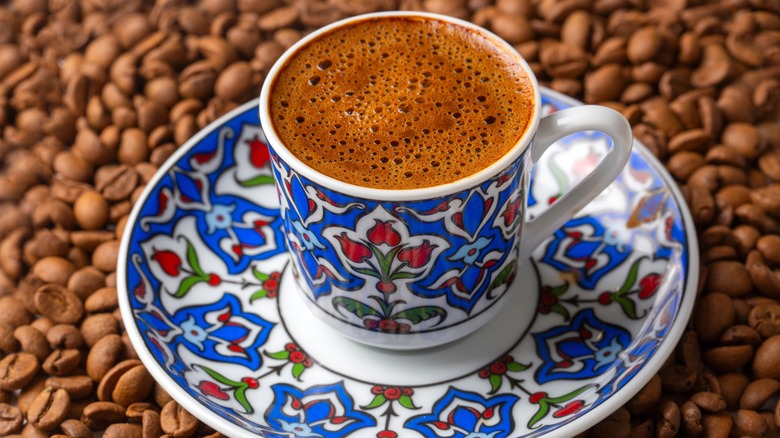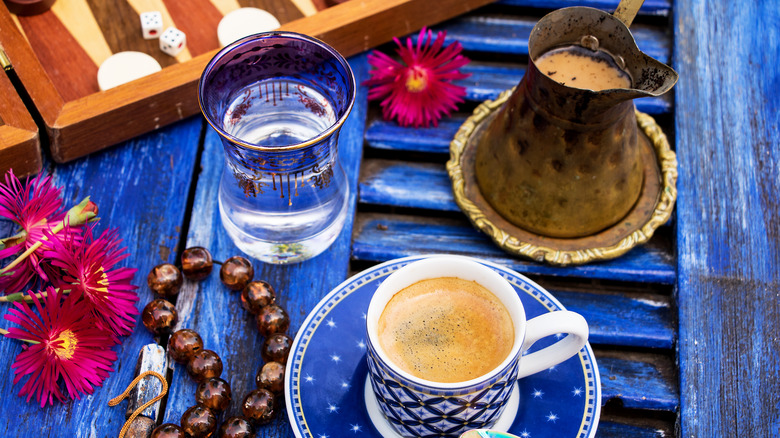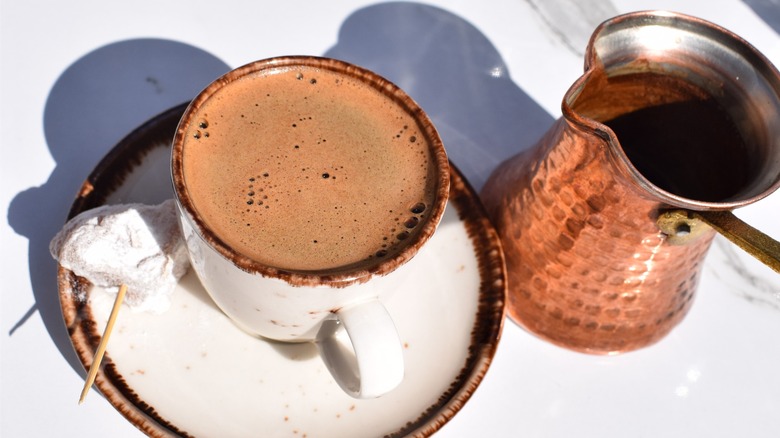Here's What Sets Greek Coffee Apart From The Rest
Coffee might not be the first thing that comes to mind when thinking about Greek cuisine (Greek yogurt does tend to get all the buzz). But the Mediterranean country's rich and unique coffee culture is certainly worth sipping on.
Greek coffee is set apart from other coffee varieties by several distinct characteristics. First of all, the coffee grounds are served in the cup. This may seem counterintuitive to Americans who associate coffee grounds with the sad dregs of an office coffee pot. But it's an essential aspect of Greek coffee culture — the drink is typically sipped very slowly, so the grounds will sink to the bottom and continue to infuse the beverage with flavorful coffee deliciousness.
Another important quality of Greek coffee is that it is incredibly strong and velvety-thick. No one is drinking an extra large Dunkin' cup of this stuff. It's typically served in two- to three-ounce portions because each sip packs a punch. Lastly (and arguably most importantly), Greek coffee has a rich, frothy foam called kaimaki on top. A good amount of foam is a tell-tale sign of a high-quality beverage because it indicates the coffee has been properly brewed and not overmixed. It also adds more texture to the drink, making for a more complex sipping experience.
How to drink Greek coffee
Greek coffee is traditionally brewed in a tall, skinny coffee pot called a briki. It requires only two or three ingredients: coffee grounds, water, and, optionally, sugar. Good news for the lactose intolerant: Greek coffee does not traditionally contain milk. Greek coffee ranges in strength and sweetness from sketos, which is made with one teaspoon of coffee and no sugar, to vary glykos, which contains two teaspoons of coffee and three teaspoons of sugar.
Almost more important than what's in Greek coffee is how it's consumed. The foamy, caffeinated beverage is traditionally enjoyed slowly over a long period of time, ideally while socializing with family and friends. In Greece, it's perfectly normal for coffee breaks to last an hour or more. It's all about savoring the moment (and the sweet, sweet caffeine).
Greek coffee is very similar to Turkish coffee — some would argue it's essentially the same thing. But don't go around talking about Turkish coffee in Athens or Thessaloniki. Due to a history of political tension, Greek coffee (or elliniko) is the preferred term, and calling it anything else won't get you far with the locals.
Why the froth is so important
The frothy, foamy crema (or kaimaki) on top of a cup of Greek coffee is one of the most uniquely delicious aspects of the drink, and what truly makes it special. If the coffee is overcooked or brewed improperly, the foam will disappear. So if you see a cafe serving Greek coffee with a nice layer of foam, it's a good sign you should stop for a coffee break.
The Greek frappe is a newer, but also extremely foamy, addition to the Greek coffee canon. As legend has it, the ice-cold, frothy delight was invented in 1957 by a Nestlé representative named Dimitris Vakondios at the Thessaloniki International Trade Fair. Nowadays, Greek frappes are typically made with water, sugar, instant coffee, and milk, mixed up with an electric frother. In the heat of summer, the Greek frappe is a refreshing alternative to hot coffee. But no matter how you sip it, Greek coffee is a thick, strong, frothy, and delicious caffeine boost.


